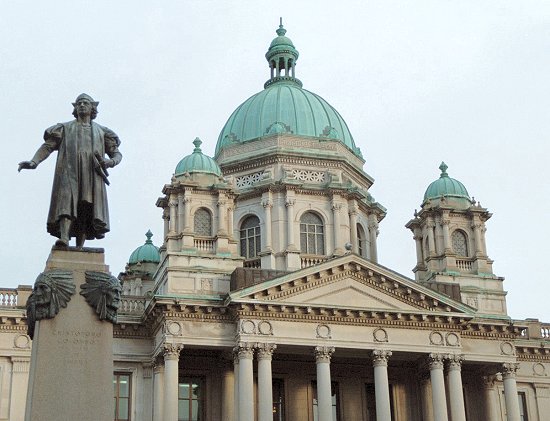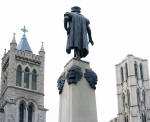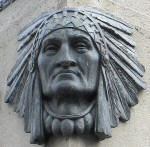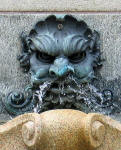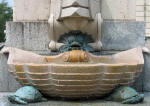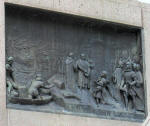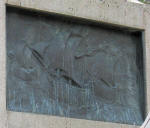|
Christopher Columbus Monument |
|
|
| Italian immigrates began coming to America in significant numbers after
the unification of Italy in 1870, when the promised land reforms didn't
materialize. By then, the Eire Canal had already been built in
Syracuse, but Italian day laborers worked on the Bare Canal and were hired
to build ralroads, streets, and water-works. The pattern of Italian settlement in Syracuse at this time reflected the kinds of work they did. They lived near the rail yards, round houses, and track along the north side and soon opened business to serve their needs as well as those of larger community. Like other immigrant groups before them, Italians were confronted by religious and ethnic bias. At the turn of the century, headlines in the local newspapers reflected concern about the increasing number of Italian immigrants. Despite this, Italian-Americans flourished here and began to feel justifiable prid in their standing in their adopted county. It was out of pride and gratitude to the Syracuse community that a group of Italian-Americans first decided to erect a monument to Columbus. The monument was the brain-child of Professor Torquato DeFelice, sculptor and painter, and Dr. Seraphino Charulli. In 1910, Professor DeFelice visited Professor Renzo V. Baldi in Florence, and returned with a model by Baldi. But it wasn't until 1928, after the election of John G. Ciciarelli as preside of the Columbus Monument Association (also referred to as Columbus Memorial Association), that the fundraising began. Fifteen "generals" raised $18,000. By then, the Baldi model had been set aside and, when the monument committee chose as its site the knoll in Onondaga Park, it staged a contest for design of the monument by American sculptors. The knoll site was later rejected in favor of a site downtown, and the contest winner filed a lawsuit when the change of site requred an entirely different design. Meanwhile, controversy over which specific site the City and Committee agreed upon continued to hod up the project. In 1930, the City Planning Commission recommended several sites: Columbus Park at E. Genesee and Cherry Streets, a plaza at the end of Forman Avenue on Eire Boulevard, Fayette Park, and Hanover Square. Of these, the monument committee liked only the Fayette Park site, but this required moving the Hamilton S. White firefighter memorial to the east end of the park across from the White mansion. This was abandoned when the honored firefighter's widow and friends objected. St. Mary's Circle, between the courthouse and the Cathedral of the Immaculate Conception, was considered but initially rejected as not being large enough. Eventually Mayor Rolland B. Marvin stepped in and, on May 16, 1931, both sides agreed to place a slightly smaller version of the Baldi monument design in St. Mary's Circle, now popularly known as Columbus Circle. There was, however, a further cause for delay. The price Baldi had set for the statue was 322,000 lire, which was very reasonable at the rate of exchange at the time. But before the work was completed, the dollar to lire ratio changed. In January, 1934, a second fundraising campaign let by Joseph J. Pietrafesa, owner of Learbury's, and William T. McCaffrey, President of Lincoln Bank, raised the necessary additional funds. On Columbus Day, 1932, the Italian-American community celebrated the ground-breaking with an enormous parade. Col. Guido F. Verbeck, head of the Manlius School, was the grand marshal. His father, the late Brig. Gen. William Verbeck, was honored by the King of Italy with a citation as chevalier in the Order of the Crown. Dwight James Baum, a graduate of Syracuse University and nationally known architect, was hired to supervise the design and construction of the monument, while Baldi sculpted the bronze work. Baum attempted to create the ambience of an Italian piazza. The modified obelisk on which the statue of the explorer stands is an ancient Egyptian symbol of power, widely used in civic monuments in Italy. Made of pink granite, it rises 29 feet above the pavement, and rests on a gray and pink granite base comprised of ancient triremes (ships' prows) representing ancient Roman vessels and symbolizing Italy's navigational prowess.
The fountain spouts are creatures of the deep, which, with the brass turtles and stone shells of the fountain, serve as reminders of Columbus' confrontation of the dangers of the sea. The pool's bottom features a navigator's compass in colored pebbles, traditional in Italian grottos and fountains. Renzo V. Baldi's Columbus is a cast bronze figure eleven feet tall. It depicts the explorer as a young man, long before he sailed to America, looking toward the west, maps and charts in his hand. Baldi's bronze bas-relief plaques depict scenes from the life of Columbus: at the Court of Queen Isabel; arriving in the tropics and; returning to the Court of Spain. Masks of Native American faces function as clasps to hold the four sections of the obelisk together, and celebrate the people who were already in America when Columbus arrived. In 1967, a portion of Montgomery Street in front of the cathedral was appropriated to enlarge the plaza. At this time, the fountain was redesigned to include a planter/seat wall, and jets of water from inside the seat wall sprayed toward the monument base. This larger plaza became a focal point of many special downtown events and a gathering place for office workers at lunch time. In 1992, in anticipation of the international commemoration of the Quincentennial of Columbus's voyage, the monument and St. Mary's Circle were completely dismantled and restored. The statue was carefully removed from the pedestal and the obelisk from the base. All bronze work, the figures of Columbus, the 4 sea creature spouts, the 4 sculpted plaques, the 8 turtles, and 4 masks were shipped to Statuary Conservations, a Division of Healy Brothers Foundry in Rhode Island, and restored and refinished with a walnut-shell blasting technique. The obelisk down to the ships' prow was removed, and its broken cp stone replaced. The plumbing and nozzles were refitted, the fountain spray restored to its original direction from the mouths of the creatures into the shells, and the pool filter system was replaced and new electrical service installed. The original masonry design was restored, from the compass in the pool bottom, to the original planter beds, to the cobble-stone paving extending to the original 85' diameter circle, with cast stone benches at the points of the compass. Outside the circle a new ring of benches was installed for additional seating.
Restoration of the monument cost $505,000, and was paid for by a New York State Environmental Quality Bond Act (EQBA) Grant ($200,000), funds raised by the Columbus Monument Memorial Association ($167,500), and City funds and in-kind services worth $137,500. Design consultants were Tourbier and Walmsley, Inc. of New York City. The project was supervised and administered by Quinlivan, Pierik & Krause, Architects/Engineers of Syracuse, with stone restoration supervised by Crawford and Stearns, Architects and Preservation Planners, also of Syracuse, Law Brothers Contracting Corporation, CNYU Mechanical Associates, Inc. and A Pompos Electric, Inc., performed the work. |
